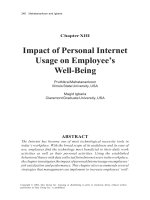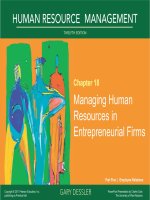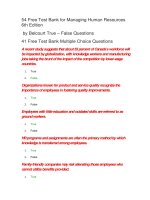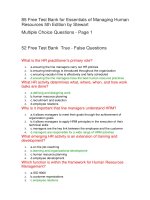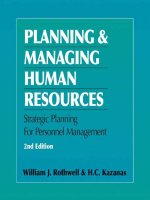7 managing human resources
Bạn đang xem bản rút gọn của tài liệu. Xem và tải ngay bản đầy đủ của tài liệu tại đây (1.31 MB, 40 trang )
Chapter 7
Managing
Human
Resources
Contemporary Management
7-1
Learning Outcomes
• Describe the key components of the human
resource management process and the important
influences on that process.
• Discuss the tasks associated with identifying and
selecting competent employees.
• Explain how employees are provided with
needed skills and knowledge.
Contemporary Management
7-2
Learning Outcomes (cont.)
• Describe strategies for retaining competent, highperforming employees.
• Discuss contemporary issues in managing human
resources.
Contemporary Management
7-3
7.1
Describe the key
components of the
human resource
management process
and the important
influences on that
process.
Contemporary Management
7-4
Management Myth
• Myth: Managers don’t need to know
about human resources because that’s
the job of the HR department.
What is your opinion about it?
Contemporary Management
1-5
Human Resource Management
The Quality Of An Organization Is Determined By The Quality Of People It Employs
Contemporary Management
7-6
A MANAGER’S CHALLENGE: MANAGING
HUMAN RESOURCES AT TRILOGYSOFTWARE
• Trilogy Software excels at recruiting, training and integrating
employees. The company spends a great deal of money on HR
and has created its own university boot camp that all new
employees attend for their first three months. This training
program, called Trilogy University, not only trains employees
but it spread into them the Trilogy’s culture. The University is
action based and the new recruits work on actual Trilogy
products. The culture at Trilogy stresses humility, creativity,
teamwork, and change.
• Questions:
1. What do you think of Trilogy’s approach to HR?
2. Is the investment in training well-invested money or a waste if people leave
after a few years?
Contemporary Management
1-7
HRM Process and Influences
Each
component
of an HRM
system
influences
the other,
and all eight
must fit
together
Contemporary Management
7-8
Exercise
• What mangers need if they decide to
decentralize authority and empower
employees?(taking into account the
relation of HRM components) .
Contemporary Management
1-9
The Legal Environment
• The primary environmental force that affects an
organization is the legal environment.
• HRM practices are governed by laws, which vary
from country to country, and further vary within
state or provinces.
• As a manager, it will be important for you to know
what you legally can and cannot do.
Contemporary Management
7-10
The Legal Environment
• Today’s employers must ensure that
equal employment opportunities exist
for job applicants and current
employees.
• Decisions regarding who will be hired
• Decisions regarding who will be trained
Contemporary Management
1-11
7.2 Discuss tasks
associated with
identifying and
selecting competent
employees.
Contemporary Management
7-12
Identifying and Selecting Employees
Let's imagine that you had to replace yourself with a new employee in 90
days.
What key skills would you look for in your replacement?
What source would you use to find your replacement?
HRM Process:
1.
2.
3.
4.
5.
Employment planning (current & future)
Recruitment and downsizing (job analysis)
Selection process
Training and development
Transfer of training and development
6.
7.
Performance appraisal & feedback
Pay and benefits
Contemporary Management
7-13
Forecast
• As part of human resource planning,
manager must make both
• Demand forecasts
Estimate the qualifications & number of employees an organization will
need to achieve its goals & strategies
• Supply forecasts
Estimate the availability & qualifications of current employees now and in
the future.
Contemporary Management
1-14
Outsourcing
• Managers decide to OUTSOURCE to fill
some of their human resources needs.
Instead of RECRUITING & SELECTING
Outsource
Org.
Recruiting
& selecting
Contemporary Management
Produce
(goods / services)
1-15
Reasons to outsource
• Flexibility
When forecasting human resource needs is difficult
• Needs vary over time.
• Finding skilled workers in a particular area.
• Cost
Outsourcing lower the cost for many reasons
• The organization doesn’t have to provide benefits to workers.
• Managers are able to contract workers when needed.
• Managers don’t invest in training.
Contemporary Management
1-16
Conducting Employee Assessments
Contemporary Management
7-17
Job analysis
Job analysis
Job
specifications
Job
description
Tasks
Duties
responsibilities
knowledge
skills
Abilities
Needed to
perform
the job
Makes up
the job
Contemporary Management
1-18
Job analysis is done in a number
of ways including:
• Observing current employees as they perform
the job.
• Interviewing them.
• Questionnaires that are completed by job
holders and their managers.
• The Position Analysis Questionnaire (PAQ) is a
comprehensive standardized questionnaire
that many managers rely on to conduct job
analysis.
Contemporary Management
1-19
Once managers have completed
planning & Job analysis
•They will know the human resource
needs & jobs to fill.
• At this point, recruitment & selection
can begin.
Contemporary Management
1-20
Recruiting Applicants
Contemporary Management
7-21
Selecting Job Applicants
Contemporary Management
7-23
Process / Steps In Selection
1.
2.
3.
4.
5.
6.
7.
8.
Preliminary Interview
Selection Tests
Employment Interview
Reference & Background Checks
Selection Decision
Physical Examination
Job Offer
Final Selection
Contemporary Management
1-24
Selection Devices: Tests
selection devices :
• written tests
• performance-simulation tests
(work sampling , assessment centers)
• interviews.
Contemporary Management
7-25
Work sampling & Assessment
centers
• Work sampling = suited to routine jobs
• Assessment centers= selection of managerial
personnel
• Example1: BMW’s factory in South Carolina have 90 minutes to
perform a verity of typical work tasks on a specially built simulated
assembly line. Work samples yield validities superior to written
aptitude and personality tests.
• Example2: A candidate might be required to play the role of a
manager who must decide how to respond to 10 memos in a basket
within a 2 hour period. Assessment centers have consistently
demonstrated results that predict later job performance in managerial
positions.
Contemporary Management
1-26
